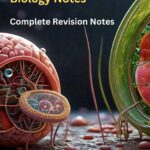 O Level Biology Notes
O Level Biology Notes
The Cambridge O Level Biology course is a secondary-level qualification for students, typically taken by those around 14-16 years old. It’s designed to provide foundational knowledge of biological concepts and scientific skills, preparing students for further studies in biology and related subjects.
Here’s an overview of what’s covered in Cambridge O Level Biology:
- Subject Content: Topics include cells and organization, plant and animal physiology, genetics, ecology, and evolution. The curriculum emphasizes core biological principles and processes.
- Scientific Skills: Students develop practical skills in conducting experiments, analyzing data, and making observations, which helps them gain a deeper understanding of scientific methods.
- Examinations: Assessment typically includes written exams with a combination of multiple-choice questions, structured questions, and a practical test or alternative-to-practical paper for those who don’t have access to lab facilities.
- Further Studies: Success in O Level Biology can lead to Cambridge International AS and A Level Biology or other advanced studies in biology, environmental science, or health sciences.
The course follows a structured syllabus set by Cambridge Assessment International Education and is recognized internationally as a rigorous and credible qualification.
Candidates study the following topics:
- Cells
- Classification
- Movement into and out of cells
- Biological molecules
- Enzymes
- Plant nutrition
- Transport in flowering plants
- Human nutrition
- Human gas exchange
- Respiration
- Transport in humans
- Disease and immunity
- Excretion
- Coordination and control
- Coordination and response in plants
- Development of organisms and continuity of life
- Inheritance
- Biotechnology and genetic modification
- Relationships of organisms with one another and with the environment
19 units
·
322 lessons
|
Last updated: November 22, 2024
|
Please login to save the post
Notes
Flashcards
Questions
MCQ Quiz
Exam Study Notes
19 units
·
322 lessons
7 topics
3 topics
5 topics
5 topics
10 topics
3 topics
6 topics
5 topics
3 topics
9 topics
4 topics
2 topics
3 topics
11 topics
3 topics
14 topics
7 topics
9 topics
3 topics
2 topics
5 topics
3 topics
8 topics
3 topics
7 topics
16 topics
7 topics
11 topics
3 topics
6 topics
10 topics
5 topics
4 topics
3 topics
4 topics
3 topics
4 topics
10 topics
4 topics
13 topics
14 topics
4 topics
5 topics
12 topics
7 topics
5 topics
4 topics
12 topics
3 topics
6 topics
3 topics
4 topics
Flashcards
Will be Added soon.....
MCQ Quiz
1 found this helpful out of 1 votes
Helpful: 100%
Helpful: 100%
Was this page helpful?
